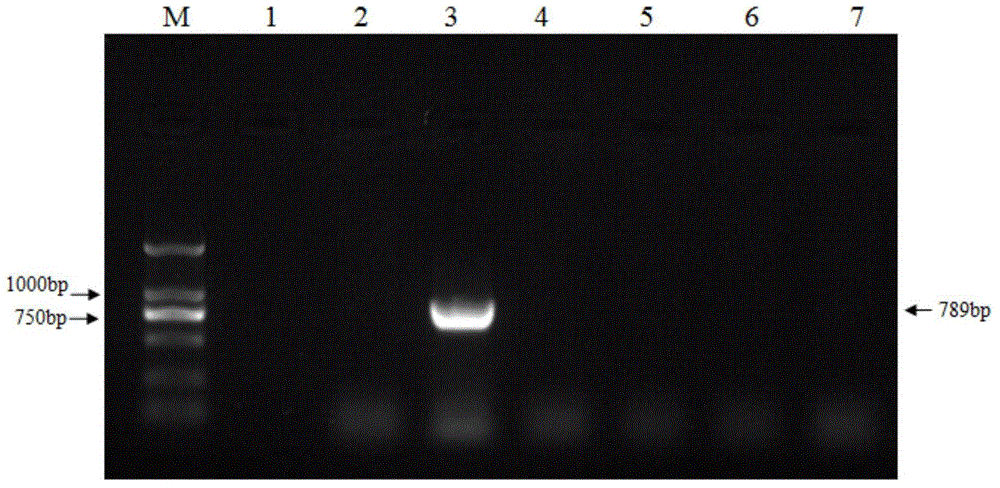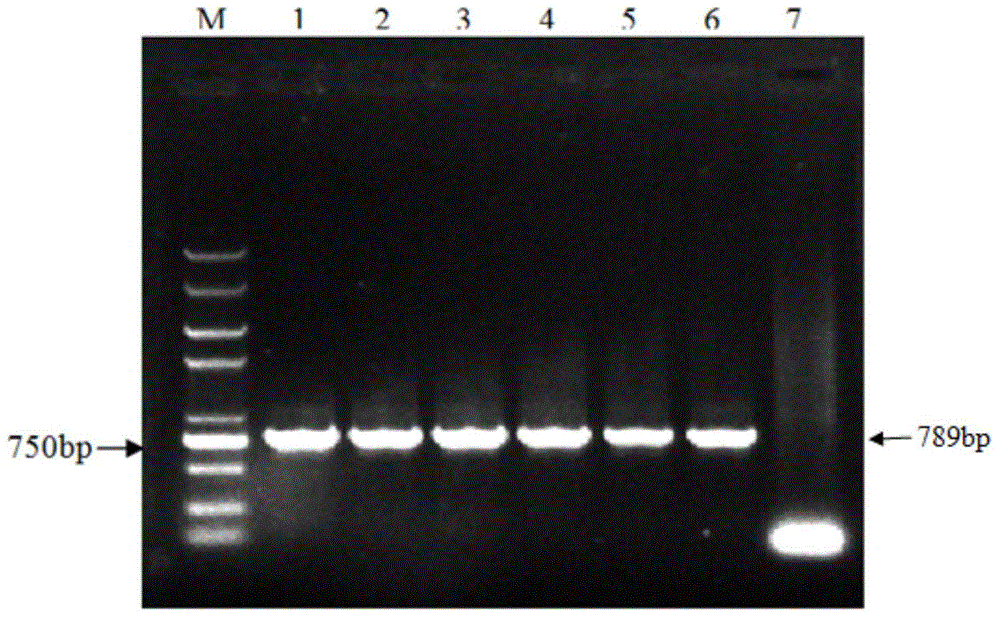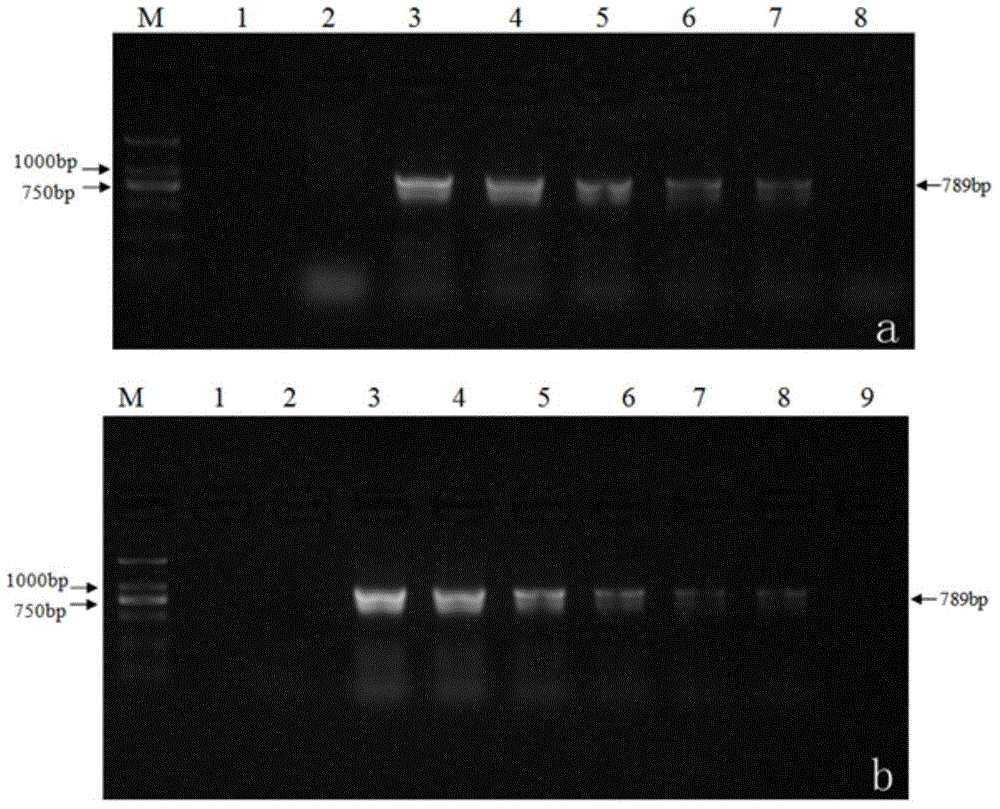Kit for rapidly detecting tomato yellow leaf curl virus and application thereof
A technology of tomato yellowing curved leaves and a kit, which is applied in the biological field, can solve the problems of large interference from human factors, unsuitability for rapid detection, and low reliability of detection results, etc., and achieve the effect of high sensitivity
- Summary
- Abstract
- Description
- Claims
- Application Information
AI Technical Summary
Problems solved by technology
Method used
Image
Examples
Embodiment 1
[0039] The preparation of embodiment 1 kit
[0040] 1. Primer design
[0041] According to the multiple sequence comparison of the nucleotide sequences of the Chinese dominant strains of tomato yellow leaf curl virus registered on NCBI, the primers were designed. The primer sequences are as follows. For the verification of the primer effectiveness, see figure 1 :
[0042] Upstream primer (TY-V1): 5'—AGTACTATGTCGAAGCGWCCAG—3' (shown in SEQ ID NO.1, W=A / T)
[0043] Downstream primer (TY-V2): 5'-TCTAGATTAATTTKRTATTGAATCATAGA-3' (shown in SEQ ID NO.2, K=G / T, R=A / G)
[0044] The size of the amplified target fragment is 789bp.
[0045] 2. Preparation of extraction buffer and washing buffer
[0046] (1) Preparation of extraction buffer (100ml)
[0047]
[0048] Add 90ml ddH 2 O, adjust the pH to 7.8, dilute to 100ml, and store at room temperature.
[0049] (2) Preparation of washing buffer (100ml)
[0050]
[0051] Add 90ml ddH 2 O, adjust the pH to 7.4, dilute to 100m...
Embodiment 2
[0053] Example 2 Application of the kit of the present invention in the detection of tomato yellow leaf curl virus
[0054] 1. Sample material: Tomato samples known to be infected with tomato yellow leaf curl virus in 7 provinces and cities were used as test objects, and healthy tomato samples were used as negative controls.
[0055] 2. Method
[0056] (1) Sample processing
[0057] Take 10 mg of tomato diseased leaves in a 1.5 mL centrifuge tube, add 100 μL of extract buffer (prepared according to the method in Example 1) and grind thoroughly; then centrifuge at 12000 rpm for 5 min; take 50 μL of the supernatant and add it to a 0.2 mL PCR tube; 37 ° C Incubate in a water bath for 10 minutes to facilitate the adsorption of virus particles on the wall of the PCR tube; pour off the liquid in the PCR tube; wash the PCR tube twice with 100 μL of washing solution buffer (prepared according to the method in Example 1); fully dry the PCR tube ;
[0058] (2) PCR amplification
[0...
Embodiment 3
[0066] The sensitivity detection analysis (detection limit analysis) of embodiment 3 inventive method
[0067] Control group: take tomato leaves infected with TYLCV, extract DNA by conventional CTAB method, dilute 1:1, 1:10, 1:100, 1:1000, 1:5000, 1:10000 times with double distilled water, perform PCR Amplified, the product was subjected to 1.2% agarose gel electrophoresis, stained with EB, and photographed on the BioRad gel imaging system, such as image 3 as shown in a.
[0068] The method of the present invention: get the tomato leaf that infects TYLCV, get 50 μ L supernatant after extracting buffer treatment, with the supernatant after extracting buffer treatment of healthy tomato plant (not infected with TYLCV) leaf, carry out 1:1, 1 : 10, 1: 100, 1: 1000, 1: 5000, 1: 10000, 1: 20000 times of dilution, the supernatants of different dilution times were respectively incubated according to the method of embodiment 2, washed with buffer solution, PCR amplification The produ...
PUM
 Login to View More
Login to View More Abstract
Description
Claims
Application Information
 Login to View More
Login to View More - R&D
- Intellectual Property
- Life Sciences
- Materials
- Tech Scout
- Unparalleled Data Quality
- Higher Quality Content
- 60% Fewer Hallucinations
Browse by: Latest US Patents, China's latest patents, Technical Efficacy Thesaurus, Application Domain, Technology Topic, Popular Technical Reports.
© 2025 PatSnap. All rights reserved.Legal|Privacy policy|Modern Slavery Act Transparency Statement|Sitemap|About US| Contact US: help@patsnap.com



